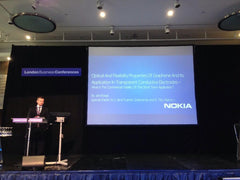more »The first Graphene Commercialisation and Applications Summit was held June 25 and 26 in London. The summit gathered key players of the graphene industry, together with those that wish to use graphene but are not yet using it, as well as investors. The variety of speakers and guests provided for a dynamic mixture, as witnessed first-hand by our CEO Jesus de la Fuente.
"The meeting helped us to establish new connections, and see what old ones are up to," says Jesus. "Graphenea definitely enjoys networking with other members of the graphene industry and this meeting provided a good environment for that."
 Speakers included lead researchers of industry giants, such as HEAD, BASF, Airbus and Volvo. HEAD proudly showed the first commercial graphene product - their now famous graphene tennis racquet. Nokia was also there, providing insight into the company's research into graphene-enabled mobile devices, as well as outlining their lead role in the European Commision's Graphene Flagship. Graphenea partners with Nokia on several projects to bring high-quality graphene to the real world market. Nokia, as well as Jari Kinaret (head of the Graphene Flagship) and the representative of Thales cited Graphenea as as their graphene producer partner. Graphenea partners with many large industrial leaders and academic research labs.
Speakers included lead researchers of industry giants, such as HEAD, BASF, Airbus and Volvo. HEAD proudly showed the first commercial graphene product - their now famous graphene tennis racquet. Nokia was also there, providing insight into the company's research into graphene-enabled mobile devices, as well as outlining their lead role in the European Commision's Graphene Flagship. Graphenea partners with Nokia on several projects to bring high-quality graphene to the real world market. Nokia, as well as Jari Kinaret (head of the Graphene Flagship) and the representative of Thales cited Graphenea as as their graphene producer partner. Graphenea partners with many large industrial leaders and academic research labs.
The conference was held in a friendly and collaborative atmosphere, with ample time for discussion and establishing new partnerships. These kinds of meetings are very welcome, as they support the coherent development of the graphene industry and help push the technology forward. We look forward to next year's meeting, at the same place around the same time!
via Graphenea
 Speakers included lead researchers of industry giants, such as HEAD, BASF, Airbus and Volvo. HEAD proudly showed the first commercial graphene product - their now famous
Speakers included lead researchers of industry giants, such as HEAD, BASF, Airbus and Volvo. HEAD proudly showed the first commercial graphene product - their now famous